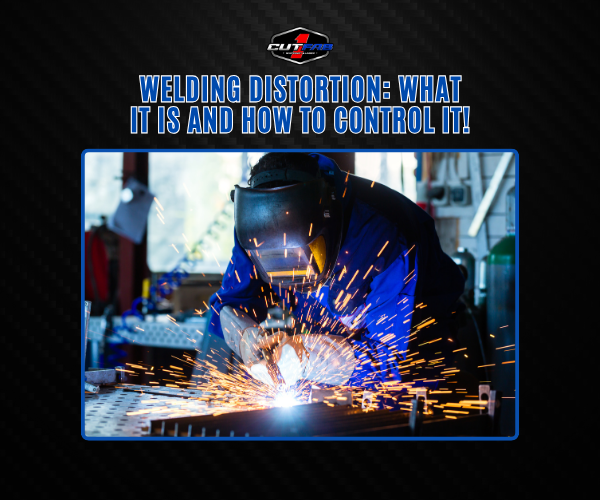
Welding Distortion: What It Is and How to Control It!
Welding distortion is a hidden enemy in metal fabrication, quietly warping your precision and compromising structural integrity. Simply put, welding distortion refers to the unintended movement or deformation of metal caused by uneven heating and cooling during the welding process. Left unchecked, it can lead to misaligned components, increased rework, and costly delays. Whether you're fabricating machinery or architectural metalwork, understanding welding distortion is essential to maintaining accuracy and quality. In this guide, we’ll break down exactly what welding distortion is—and give you proven strategies to control it before it ruins your next project.
What Causes Welding Distortion
Welding distortion doesn’t happen by accident—it’s a direct result of the physical forces at play during the welding process. The key culprit? Uneven heat input.
When a weld is applied, intense localized heat expands the metal. As it cools, that same area contracts. If the heat isn’t distributed evenly, this expansion and contraction cause warping, twisting, or bowing—what we collectively refer to as welding distortion. The greater the heat input, the higher the likelihood of imbalance, especially if the cooling is rapid or unregulated.
But it’s not just about the torch. Material thickness also plays a major role. Thin materials are more prone to distortion because they offer less resistance to thermal movement. In contrast, thicker materials absorb and distribute heat more evenly, reducing distortion—but only if properly managed.
Clamping and fixturing techniques further influence outcomes. Inadequate clamping allows parts to shift under thermal stress, while over-clamping may restrict natural movement and create internal stresses that show up later as distortion.
Welding distortion is the result of physics—but with the right understanding of heat control, material behavior, and fixturing strategy, you can significantly reduce its impact. In the next section, we’ll explore the most common types of distortion you’re likely to encounter on the shop floor.
Prevention Techniques Used by Pros
Experienced fabricators know that avoiding welding distortion is all about strategy. While some distortion is inevitable due to the nature of thermal expansion and contraction, professionals rely on a toolbox of techniques to keep it under control.
One of the most effective methods is backstepping. Instead of welding a seam continuously from start to finish, the welder uses short, staggered welds in the opposite direction. This distributes heat more evenly and reduces the chance of excessive shrinkage in one area. When combined with stitch welding—a technique where intermittent welds are placed in a sequence rather than continuously—heat input is minimized without compromising structural integrity.
Another powerful distortion-fighting tactic lies in proper joint design. Professionals design weld joints to allow for controlled movement and even heat distribution. For example, choosing a double-V groove instead of a single bevel can help balance heat on both sides of the joint, reducing angular distortion. Additionally, ensuring tight fit-up and minimal gaps between pieces reduces filler material usage, which directly correlates with reduced heat and shrinkage.
Ultimately, the key to minimizing welding distortion isn’t just technique—it’s planning. With deliberate joint design and strategic welding practices like backstepping and stitch welding, pros stay one step ahead of distortion before the arc even strikes.
Post-Weld Straightening Methods
Even with the best prevention techniques, welding distortion can still creep into a finished part. That’s why seasoned fabricators always have a backup plan—post-weld straightening methods. These corrective strategies are designed to bring warped or misaligned components back into spec without compromising strength or appearance.
One widely used technique is heat straightening. This process involves applying controlled heat to specific areas of the metal to induce localized expansion. As the area cools, it contracts and pulls the distorted metal back into alignment. The key is precision—too much heat can worsen the distortion or even damage the material. Pros typically use an oxy-acetylene torch and carefully map out heat patterns, often working in triangles or crescents to produce uniform movement.
Another effective solution is mechanical pressing. In this method, hydraulic or manual presses are used to force the distorted area back into shape. This technique is especially useful for heavier-gauge materials where heat straightening might be inefficient. Fixtures and dies are often used to maintain geometric consistency and avoid introducing new stress points.
While these techniques aren’t a substitute for prevention, they’re vital tools in a fabricator’s arsenal. When welding distortion happens, knowing how to fix it quickly and effectively can be the difference between salvage and scrap.
Conclusion
Welding distortion isn’t just a nuisance—it’s a costly threat to precision, efficiency, and project timelines. But the good news? It’s entirely manageable with the right approach. By understanding what causes distortion—like uneven heat input and poor joint preparation—you can take proactive steps before striking an arc. Techniques like backstepping, stitch welding, and smart joint design go a long way in minimizing warping from the start.
And when distortion does occur, heat straightening and mechanical pressing offer reliable recovery options to get your work back on track without starting over.
The pros know that controlling welding distortion isn’t about working harder—it’s about working smarter. With thoughtful planning, strategic welding methods, and the right tools, you can ensure weld accuracy, reduce rework, and deliver high-quality results every time.
Ready to eliminate distortion from your workflow? Start implementing these strategies today—and weld with confidence.
